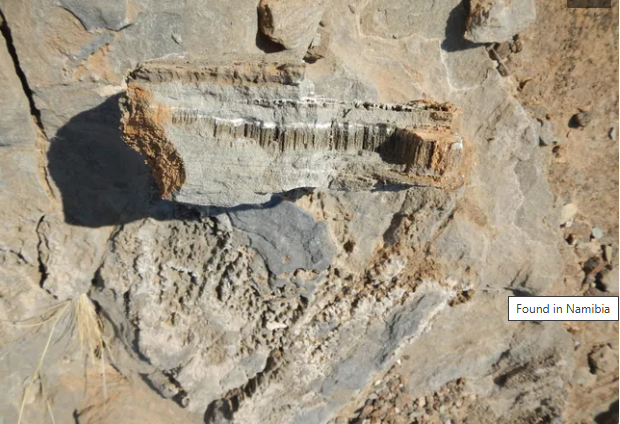Scientists at the University of Mainz have discovered strange rock tubes in Namibia and other desert regions. They suspect that previously unknown microorganisms lived in them—or still do.

A team of researchers from the University of Mainz encountered a strange phenomenon while working in several desert areas: They discovered unusually small holes in marble and limestone – tiny tubes that run parallel through the rock from top to bottom. “We were surprised because these tubes are apparently not the result of a geological process,” says Cees Passchier, one of the scientists involved, according to a statement from the university.
Rather, the researchers interpret the mysterious tubes as traces of previously unknown microorganisms. “Whether this is a life form that has become extinct or is still alive somewhere, we don’t currently know,” explains Passchier.
 A piece of marble found in Namibia: Starting from a crack filled with white calcium carbonate, tubes have grown downwards in a parallel arrangement Photo: Cees Passchier
A piece of marble found in Namibia: Starting from a crack filled with white calcium carbonate, tubes have grown downwards in a parallel arrangement Photo: Cees Passchier
According to the scientists, the microorganisms apparently perforated the rock. They may have “drilled the tunnels to utilize nutrients in calcium carbonate, the building block of marble,” the statement continued. The reason for this assumption: The tubes were not empty, but filled with a fine powder of pure calcium carbonate.
Tubes could be millions of years old
The phenomena were discovered in the desert regions of Namibia , Oman , and Saudi Arabia. They are said to be about half a millimeter wide and up to three centimeters long. They are arranged parallel to one another, forming bands up to ten meters long. “In all cases, these are ancient structures, perhaps one or two million years old,” explains Passchier.
The first discoveries were made in Namibia 15 years ago. Passchier and her colleagues have since examined the finds more closely. However, the exact organism that caused these structures remains a mystery.
 Found in Namibia Photo: Cees Passchier
Found in Namibia Photo: Cees Passchier
Between 500 and 600 million years ago, the continents coalesced to form the supercontinent Gondwana. At that time, limestone deposits formed in the ancient oceans, which, due to pressure and heat, transformed into marble. According to Passchier, the strange structures, which are not the result of geological events, fell into this marble.
Researchers found no DNA or proteins
According to the report, microorganisms such as bacteria, fungi, or lichens occur even in inhospitable or remote corners of the Earth . “So-called endolithic microorganisms are not uncommon in desert areas: They can obtain their energy and nutrients from the colonized rock,” it continues.
According to Passchier, it must be an organism that requires nutrients from calcium carbonate to survive, but can survive without light because the tubes are located deep within the rock. Although biological material has been found, no DNA or proteins have been found that could provide further insights. Whether the mystery of the tubes can be solved remains unclear
Unknown Life Form Discovered in Desert Marble and Limestone
Researchers from Mainz University have uncovered evidence of previously unknown microorganisms in marble and limestone formations located in desert regions. These findings suggest the potential existence of a life form, either extinct or still living, yet its precise nature remains uncertain.
In a recent study published in the Geomicrobiology Journal, the team identified peculiar tubular structures measuring approximately half a millimeter in diameter and extending up to three centimeters in length. These tubes were found in various desert areas, including Namibia, Oman, and Saudi Arabia, where they align in parallel formations, creating bands that can reach lengths of up to ten meters.
The initial discovery of these structures dates back 15 years in Namibia, but further investigation has provided new insights into their origins. According to geologist Cees Passchier, it is hypothesized that microorganisms may have excavated these tunnels to access nutrients found in calcium carbonate, the primary component of marble. These structures are believed to be ancient, possibly ranging from one to two million years in age, although the specific organism responsible for their creation is still a mystery.
The geological context of these findings is intriguing. Around 500 to 600 million years ago, the continents converged to form the supercontinent Gondwana, during which time limestone deposits formed in ancient oceans. Over millions of years, geological processes transformed these deposits into marble, within which the unusual structures were discovered. Passchier noted that these formations do not appear to be the result of geological events.
This research opens new avenues for understanding microbial life in extreme environments and could have implications for the study of life on other planets, where similar conditions may exist. The ongoing exploration of these structures will likely yield further insights into the history of life on Earth and the adaptations of microorganisms to harsh environments.
Frequently Asked Questions
Researchers found no DNA or proteins ?
Unknown life forms discovered living in marble and limestone rocks ?
An Unknown Lifeform Made Structures In Namibian Desert Rock Over A Million Years एगो?











Zeeshankahloon
Hasilpur